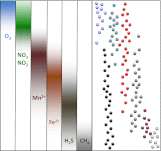Tracking microbial habitats in subseafloor sediments
- PMID: 23047701
- PMCID: PMC3479487
- DOI: 10.1073/pnas.1215867109
Tracking microbial habitats in subseafloor sediments
Conflict of interest statement
The author declares no conflict of interest.
Figures

Comment on
-
Correlating microbial community profiles with geochemical data in highly stratified sediments from the Arctic Mid-Ocean Ridge.Proc Natl Acad Sci U S A. 2012 Oct 16;109(42):E2846-55. doi: 10.1073/pnas.1207574109. Epub 2012 Oct 1. Proc Natl Acad Sci U S A. 2012. PMID: 23027979 Free PMC article.
References
-
- Fry JC, Parkes RJ, Cragg BA, Weightman AJ, Webster G. Prokaryotic biodiversity and activity in the deep subseafloor biosphere. FEMS Microbiol Ecol. 2008;66(2):181–196. - PubMed
Publication types
MeSH terms
LinkOut - more resources
Full Text Sources

